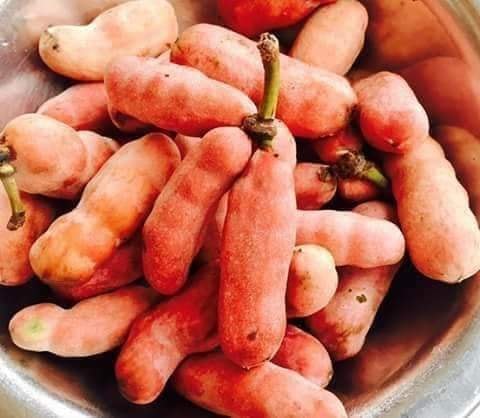Dennettia tripetala

|
|
Dennettia tripetala Common Names: Pepperfruit, Nigerian Pepperfruit, Bush
Pepper Scientific
Classification Kingdom: Plantae Clade: Tracheophytes Clade: Angiosperms Clade: Magnoliids Order: Magnoliales Family: Annonaceae Genus: Dennettia Species: D. tripetala Binomial Name: Dennettia tripetala (Baker f.) G.E. Wickens Synonyms: Morphological Description Dennettia tripetala is a small tree or woody shrub, typically 12–18 m tall, with
a girth up to 60 cm. Key features include: · Stem: Soft, white wood, fibrous bark with a pungent scent,
susceptible to termite damage · Leaves: Elliptic, 7.5–15 cm long, 3.8–6.3 cm wide, shortly acuminate,
glossy green, peppery when young · Flowers: Small, light brown outside, red inside, 5–8 mm across, in
clusters, blooming March–May · Fruit: Oblong, 2–3 cm long, green when unripe, red when ripe,
finger-like carpel constrictions, spicy taste Distribution and Habitat Dennettia tripetala is native to West Africa, thriving in: · Regions: Tropical rainforests, secondary forests, cultivated lands · Countries: Nigeria, Ghana, Cameroon, Ivory Coast, Sierra Leone, Guinea · Climate: Humid tropical, 25–35°C, rainfall 1,500–2,500 mm annually · Soil: Fertile, well-drained, loamy, pH 5.0–6.5 Ethnopharmacology Dennettia tripetala, commonly known as
pepper fruit, is a tropical West African plant with a wide range of medicinal
properties. Traditionally used in herbal medicine, it possesses strong
antioxidant, antimicrobial, anti-inflammatory, and analgesic effects.
Scientific studies have shown its potential in managing conditions like
diabetes, hypertension, and cardiovascular diseases, while also demonstrating
anticancer and neuroprotective activities. It is known to aid digestion,
stimulate appetite, support respiratory health, and may enhance fertility and
cognitive function. These benefits are attributed to its rich content of
bioactive compounds such as flavonoids, phenols, and essential vitamins.
However, while promising, most findings are based on preliminary or animal
studies, and further research is needed to establish safe and effective
therapeutic use in humans. Antimicrobial: Seed essential oil inhibits Escherichia coli and Staphylococcus aureus (MIC 0.5–1 mg/mL); used for infections
(Okoh et al., 2016). · Digestive: Traditionally, the fruit has been consumed to aid digestion. · Antioxidant: There have been some studies indicating the plant has
antioxidant properties. Aqueous extract of unripe DT possesses greater
antioxidant ability compared to ripe DT as typified by higher reducing power,
greater ability to scavenge ABTS, DPPH, and OH, as well as higher Fe reducing
and chelating potential (Adedayo, et
al., 2010). · Pain Relief: Essential oil in Ghana rivals morphine in rodents (ED₅₀ 50
mg/kg); used for toothache (Oyemitan et al., 2008). · Anti-inflammatory: Bark in Cameroon reduces edema; oil
matches dexamethasone in rats (56% inhibition at 100 mg/kg) (Oyemitan et al.,
2008). · Hepatoprotective: Leaf extracts in Nigeria protect liver;
restore ALT/AST levels in CCl₄-treated rats (Omage et al., 2021). Phytochemistry Medicinal properties
stem from bioactive compounds: · Terpenoids: β-caryophyllene, linalool—antibacterial, analgesic (Okoh et
al., 2016) · Alkaloids: Uvariopsine—antioxidant, hepatoprotective (Omage et al.,
2021) · Phenolics: Antibacterial, digestive aid · Essential Oils: 1-nitro-2-phenylethane—anxiolytic,
analgesic (Oyemitan et al., 2019) ⚠ Toxicity Profile: No acute toxicity at culinary doses; LD₅₀ >
2,000 mg/kg in rats. High doses (1,000 mg/kg) of seed oil may alter
liver/kidney function and cause behavioral changes in rats. Habitual excessive
consumption may pose risks (Daniyan et al., 2021). Additional Uses · Culinary: Fruits flavor soups, stews, and zobo drinks; seeds as spice · Cultural: Used in Nigerian ceremonies, symbolizing hospitality · Economic: Wood for fuel; fruit in pest control and preservation · Ecological: Vulnerable (IUCN); supports local biodiversity References
External Links More Pictures |
|
| Compounds of Dennettia tripetala | |
| References |